Analyzing The Great Decoupling: Trends, Drivers, And Future Scenarios

Table of Contents
Trends Shaping the Great Decoupling
Diverging Economic Growth Trajectories
The global economy is no longer characterized by uniform growth. We see a widening gap in economic performance between different regions and nations. The economic divergence is stark, with some regions experiencing robust growth while others struggle.
- Examples: The contrasting growth rates of the US and China, the differing economic recoveries of developed and developing nations post-pandemic, showcase this divergence.
- Implications: This uneven growth significantly impacts global trade patterns, investment flows, and the overall balance of global power.
- Technological Advancements: Technological advancements, while offering opportunities, also exacerbate this disparity. Access to and control over key technologies contribute to economic divergence. For example, advancements in AI and 5G are creating winners and losers, widening the gap between technologically advanced and less-advanced nations. The uneven distribution of these technologies further fuels regional disparities and contributes to the Great Decoupling.
Shifting Global Supply Chains
The traditional model of globally integrated supply chains is fracturing. Companies are actively relocating manufacturing and sourcing operations, prioritizing resilience over cost minimization. This shift is driven by several factors, including geopolitical instability and the desire to reduce reliance on single sources.
- Nearshoring and Reshoring: Many companies are adopting nearshoring (relocating production to nearby countries) and reshoring (bringing manufacturing back to their home countries) strategies to enhance supply chain resilience and reduce geopolitical risk.
- Geopolitical Instability: Trade wars, sanctions, and political instability are key drivers of this relocation. The risk of disruptions in supply chains, due to political events or natural disasters, is a major concern for businesses.
- Impact on Global Trade Patterns: This shift is dramatically altering global trade patterns, leading to a more regionalized approach to manufacturing and distribution. The long-established global supply chains, heavily reliant on specific countries, are now being re-evaluated and decentralized.
Technological Fragmentation
A crucial aspect of the Great Decoupling is the increasing fragmentation of technology. Different geopolitical blocs are developing divergent technological standards and ecosystems, leading to a splintering of the digital world.
- Differing Technology Standards: We're witnessing the emergence of competing standards in areas like 5G, AI, and semiconductors, hindering seamless cross-border collaboration.
- Data Security and Cross-Border Collaboration: Concerns about data security and national security are driving nations to develop their own technological infrastructure, limiting interoperability and data sharing across borders.
- Digital Sovereignty: The pursuit of "digital sovereignty" – the ability of nations to control their own digital infrastructure and data – is a key driver of technological decoupling. This focus on national control limits cross-border data flows and cooperation.
Drivers of the Great Decoupling
Geopolitical Tensions
Geopolitical rivalries and conflicts are major catalysts of the Great Decoupling. Escalating tensions between major powers are leading to trade wars, sanctions, and reduced economic cooperation.
- Trade Wars and Sanctions: The imposition of tariffs, sanctions, and trade restrictions disrupts established trade relationships and fuels economic nationalism.
- International Relations: Strained diplomatic relations further hinder cooperation and investment between nations, contributing to economic isolation.
- Political Instability: Political instability in various regions further exacerbates the fragmentation of global supply chains and economic ties.
Technological Competition
Fierce competition in key technologies like AI, 5G, and semiconductors fuels the decoupling process. Nations are vying for technological leadership, leading to increased protectionism and investment in domestic capabilities.
- AI and 5G: The race to dominate in AI and 5G technologies is creating a strategic competition that contributes to technological decoupling.
- Semiconductor Technology: Control over the semiconductor industry is becoming a key strategic asset, leading nations to invest heavily in domestic production and limit exports.
- Technological Nationalism: The rise of technological nationalism is a major driver, with countries prioritizing domestic innovation and technological independence.
Economic Nationalism and Protectionism
The resurgence of protectionist policies, driven by economic nationalism, significantly contributes to the Great Decoupling. Countries are increasingly prioritizing domestic industries through tariffs, subsidies, and other trade barriers.
- Tariffs and Subsidies: The use of tariffs and subsidies to protect domestic industries restricts international trade and investment.
- Trade Barriers: Various non-tariff barriers also limit the free flow of goods and services across borders, furthering economic fragmentation.
- Trade Policy: Changes in trade policies, often driven by domestic political considerations, contribute to the overall decoupling trend.
Future Scenarios of the Great Decoupling
A Multipolar World
One potential future scenario is a multipolar world with several competing economic and technological blocs. This would lead to a more fragmented global economy, with reduced cross-border cooperation.
- Geopolitical Competition: This scenario would likely involve increased geopolitical competition and potential for conflict over resources and technological dominance.
- Economic Blocs: Different economic blocs would emerge, potentially leading to the creation of parallel trade and financial systems.
- Emerging Economies: Emerging economies would play a crucial role in shaping this new multipolar world, potentially forging new alliances and trade partnerships.
Increased Regionalization
Another possible future involves a greater emphasis on regionalization, with increased economic activity and trade concentrated within specific geographic areas.
- Regional Integration: We could see increased regional integration, with the formation of stronger regional trade blocs and agreements.
- Regional Trade Agreements: Existing and new regional trade agreements would become increasingly important in shaping regional economic activity.
- Localized Economies: This regionalization could lead to a rise of more localized economies, less reliant on global supply chains.
A Path Towards Cooperation
Despite the current trends, there remains the possibility of renewed global cooperation and integration. However, this would require significant efforts to address the underlying drivers of the Great Decoupling.
- Global Cooperation: Renewed global cooperation would require greater diplomacy and efforts to reduce geopolitical tensions.
- International Institutions: International institutions would need to play a more active role in fostering cooperation and promoting global rules-based systems.
- Multilateralism: A renewed commitment to multilateralism and international agreements would be essential for achieving this outcome.
Conclusion
The Great Decoupling is a profound shift in the global economic landscape, driven by a confluence of geopolitical tensions, technological competition, and rising economic nationalism. This analysis has explored key trends, including diverging economic growth trajectories, shifting global supply chains, and technological fragmentation. Several future scenarios are possible, ranging from a multipolar world with competing blocs to a more regionalized economy, or even a potential return to increased global cooperation. Understanding the dynamics of the Great Decoupling is crucial for navigating the evolving global economic landscape. Stay informed and prepare your business for the future by continuing to explore the complexities of this significant shift. Further research into the specific implications for your industry and region is highly recommended.

Featured Posts
-
 Harry Styles Snl Impression The Reaction That Broke The Internet
May 09, 2025
Harry Styles Snl Impression The Reaction That Broke The Internet
May 09, 2025 -
 Summer Travel Everything You Need To Know About Real Id
May 09, 2025
Summer Travel Everything You Need To Know About Real Id
May 09, 2025 -
 Inquiry Into Nottingham Attacks Nhs Trust Leaders Full Cooperation
May 09, 2025
Inquiry Into Nottingham Attacks Nhs Trust Leaders Full Cooperation
May 09, 2025 -
 73 000
May 09, 2025
73 000
May 09, 2025 -
 Is Daycare Harmful A Psychologists Claims And The Expert Response
May 09, 2025
Is Daycare Harmful A Psychologists Claims And The Expert Response
May 09, 2025
